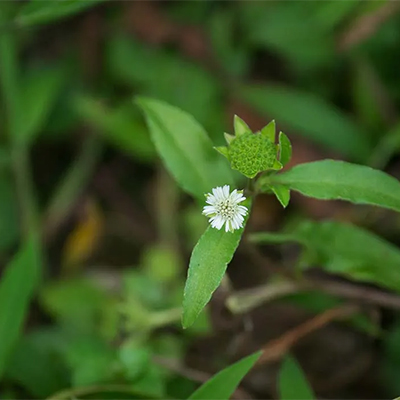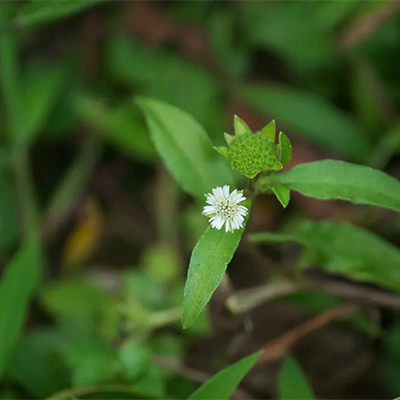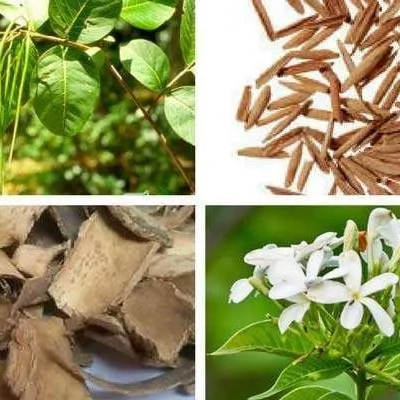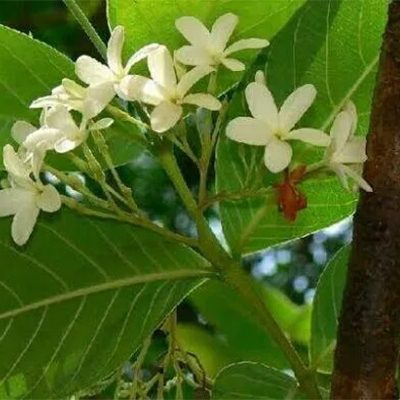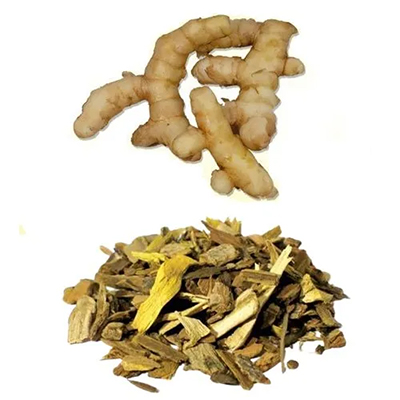On This Page
Bhringraja- Excellent hair and liver tonic
Introduction
False daisy commonly known as Bhringraja is a wild plant with ethnomedicinal significance and it is considered a weed by farmers. Botanically Bhringraja is known as Eclipta alba and belongs to the Asteraceae family. Bhringraja is folk medicine that is equally famous in Ayurveda and Siddha systems of medicine. Bhringraja exhibits extraordinary medicinal properties like anti-stress, analgesic, immunomodulatory, anti-bacterial, anti-cancerous, etc due to various chemical constituents present in it like Flavonoids, saponins, coumestans, triterpene, steroids, etc. Since ancient times Bhringraja is used to treat various skin disorders, eye disorders, various hair problems like hair fall, premature hair greying, etc. Along with this Bhringraja is an excellent liver tonic a sit improves liver function, increases the production of bile, and enhances metabolism.
Basonym of Bhringraja
भृङ्ग इव राजते।
The flowers of Bhringraja shine like honeybees.
Synonyms of Bhringraja
- According to habitat
भृङ्ग रज – भृङ्गान रञ्जयति इति।
Plant attracts honeybees.
भृङ्गव्हा – भृङ्ग माह्वयते स्पर्धते।
Bhringraja plant attracts honey bees.
केश राज: – केशा: राजन्ते अनेन केश्य त्वात इति।
Bhringraja has a very good effect on hair and gi8ves natural black hair. If used, hair will become very beautiful.
केश रञ्जन – केशानां रञ्जन: केश्य त्वात इति।
Bhringraja nourishes hair and gives natural black hair.
मार्कव: – मारयति केश शौक्लयम विनाशयति।
Bhringraja prevents premature greying of hairs.
Regional names of Bhringraja
- Trailing eclipta, False Daisy (English)
- Kesuriya (Bengali)
- Bhangra (Punjabi)
- Bhangaro (Gujrati)
- Bhangra (Hindi)
- Garuga (Kannada)
- Kayyunni, Jala Bhangra (Malayalam)
- Maka (Marathi)
- Kayanthakara (Tamil)
- Guntagalagaraku (Telegu)
Botanical Name
Eclipta alba Hassk.
Eclipta is derived from the word Ekleipo which means to be deficient.
Alba means white.
Family
Asteraceae (Bhringraja Kula)
Ayurveda reference for Bhringraja (Eclipta alba Hassk.)

Scientific classification of the Bhringraja
| Kingdom | Plantae |
| Class | Dicotyledons |
| Subclass | Gamopetalae |
| Series | Inferae |
| Order | Asterales |
| Family | Asteraceae |
| Genus | Eclipta |
| Species | alba |
Classification of Bhringraja as per Charaka and Sushruta
- Charaka: Not mentioned.
- Sushruta: Not mentioned.
Bhringraja’s description in Brihtrayi as Bhringa synonym
Bhringa ordinarily means leaf, but it has been used as a synonym for Bhringraja and Tvaka.
- Charaka Samhita: C. S. Chi. 24/ 179, C. S. Ka. 7/ 33
- Shusruta Samhita: S. S. Chi. 25/ 30, S. S. Ka. 8/ 54, 56, S. S. U. 47/ 52
- Vagbhata: A. H. Chi. 3/ 48, A. H. Chi. 19/ 83, A. H. Ka. 2/ 13, A. H. U. 2/ 66, A. H. U. 13/ 34, 46, A. H. U 16/ 57, A. H. U. 24/ 35, A. H. U. 39/ 174
Bhringraja’s description in Brihtrayi
It appears that later a different plant Wedelia calendulacea Less. It was also used under the name of Pitta Bhringraja by the Vaidyas.
- Charaka Samhita: C. S. Chi. 4/ 67, C. S. Chi. 18/ 116, C. S. Chi. 26/ 262, C. S. Ka. 1/ 28
- Shusruta Samhita: S. S. Chi. 25/ 28, S. S. Ka. 8/ 54, 56, S. S. U. 39/ 224, S. S. Ka. 51/ 29
- Vagbhata: A. H. U. 24/ 37, 42, A. H. U. 39/ 162
Bhringraja’s description in Brihtrayi as a Maarkav synonym
- Charaka Samhita: C. S. Vi. 7/ 22, C. S. Chi. 26/ 265, 267
- Shusruta Samhita: S. S. Chi. 7/ 24, S. S. Chi. 17/ 42, S. S. Chi. 19/ 47, S. S. Chi. 20/ 28, S. S. Chi. 25/ 32, S. S. U. 53/ 10
- Vagbhata: A. H. Chi. 5/ 36, A. H. Chi. 20/ 8, 30, A. H. U. 13/ 13, A. H. U. 32/ 33, A. H. U. 39/ 165
Historical background of Bhringraja
Bhringraja is known for therapeutics since very early times. Paraskara Grhyasutra, Kesava Paddhati, Sounakiya Atharva, Kousika Sutra, etc deliniate Bhringraja (Bhringaraka) for its cosmetic as well as medicinal value. It is said to be used for Shvitra and Palita. It is also used with other drugs like Haridra, Nilika, and the flowers of Indraparun. As a hair tonic, it may be used along with Kakamachi fruit juice externally. Though it is not described by Brhattrayi in the Gana and Varga, it is an important herb in therapeutics. Charaka indicated it for Raktapitta while Vagbhata advocated its consumption for one month to have the Rasayana effect. In Rajanighantu the blue variety is claimed to be the best Rasayana. At present, its hepatoprotective role is well established and used in hepatitis.
External morphology of Eclipta alba
- Habit- Bhringraja is an annual herb.
- Root- Roots of Bhringraja are Branched, and Eclipta alba exhibits the tap root system.
- Stem- The stem of Bhringraja is herbaceous, aerial, erect, cylindrical, branched, solid, glabrous, and hairy.
- Leaf- Leaf of Eclipta alba are Ramal and cauline, simple, opposite, decussate, sub-sessile, exstipulate, elliptical, and acute with reticulate venation.
- Inflorescence- Capitulum: ray florets (peripheral flowers) are ligulate, and disc florets (Central flowers) are tubular, with an involucre of bracts present.
- Ray floret- Bracteate, sessile, incomplete, zygomorphic, unisexual, pistillate, tetramerous, epigynous, cyclic, peripheral. Sepals are 4, white, and petals are 4. The androecium is absent or highly reduced. The ovary is inferior. The gynoecium is carpellary syncarpous, Disc florets are sessile, complete, actinomorphic, bisexual, tetramerous, white, central in position, sepals are 4, reduced to pappus Petals are 4, gamopetalous, tubular stamens are 4, Gynoecium is bicarpellary syncarpous, inferior ovary and unilocular.
- Fruit- Cypsela
Flowering and fruiting time
Flowering and fruiting of Eclipta alba occur between August to September i.e between the rainy season and autumn season.
External morphology of Wedelia calendulacea
- Habit: A perennial herb 0.3- 0.9 meters in height.
- Stem: The stem of Wedelia calendulacea is procumbent at the base and rooting at the lower nodes, terete, more or less hairy.
- Leaves: Leaves are opposite, subsessile, 2.3- 7.5 cm by 1.2- 8 cm., lanceolate-oblong, entire or irregularly crenate- serrate, scabrous with short white hairs or at length more or less glabrous, base tapering.
- Flower: Heads 2- 3.2 cm. diam, solitary, peduncles 2.5- 15 cm. long, erect, slender, slightly obovate, hairy, subglobose, much longer than the disk-flowers. Ray-flowers ligulate, ligules yellow, 2- 3 toothed. Style-arms of female flowers are long, acute, and recurved. Pappus is a toothed membranous cup. Achenes of the ray tapering, slightly pubescent.
- Flowering and fruiting time: Rainy (herb) season to autumn seasons.
Distribution of Bhringraja
It is found throughout India ascending to 1700 meters altitude from sea level especially nearby marshy places as a weed. It is growing frequently in different zones in the country e.g., Assam, Andhra Pradesh, Gujrat, Jammu and Kashmir, Uttar Pradesh, Kerala, Maharastra, Tamilnadu, West Bengal, and other provinces. The plant grows profusely near slow streams, in swampy areas, riverbeds, sewage, drains, and other similar habitats. It gives out bigger leaves and herbs when grown along with algae-infested swampy localities. It has distribution in Bengal, Burma, Malay Peninsula, Central India, Punjab, West Rajputana, Peninsular India, Ceylon, Malaya, and cosmopolitan to warm climatic regions (Asia).
Distribution of Wedelia calendulacea Less
It is found in Bengal, Assam, Burma, Konkan, plains areas of Madras (Tamil Nadu) in India, Ceylon, Malay Archipelago, China, and Japan.
Microscopy of Bhringraja
The leaf epidermis is composed of a single layer of parenchyma cells with characteristics of glandular trichomes on both surfaces. In transection, the stem is circular in outline with a ring of collateral ends each vascular bundle of varying size and a central parenchymatous pith. The root has a diarch structure with normal and secondary growth, prominent multicellular secondary xylem rays are seen. The endodermis is distinct. Few layers of cork cells are present.
The useful part of Bhringraja
Panchanga (Leaves, stem, flower, roots & fruits)
Dried the whole herb with flowers and fruits, stems, cylindrical up to 4 mm thick, reddish-brown. Leaves long lanceolate, narrowed at both ends, having a rough surface of dark green color which is covered with white adpressed hair. flower heads are in pairs, axillary or terminal, with white ray florets and yellow or black disc (when ripe). It has a mild odor and bitter taste.
Important phytoconstituent of Bhringraja
- Leaves: Alpha- terthienyl- methanol, stigmasterol, B-amyrin, Desmethyl wedelolactone glucoside Amino acids- cysteine, glutamic acid, phenylalanine, tyrosine, and methionine.
- Whole plant: Phytosterol- A, beta -amyrin, Wedelolactone, Triterpenic acid, dimethyl wedelolactone, fatty acids like- palmitic, stearic, oleic, and linoleic acids, nicotine.
- Root: Hentriacontanol, 14- heptaosanol, stigmasterol.
Recent research on Bhringraja
- The antidiabetic effect of the ethanolic extract of Eclipta alba (EA) on hyperglycemia and diabetic nephropathy was investigated in streptozotocin-induced diabetic rats. The results suggest that EEA possesses an antidiabetic effect associated with alpha-glucosidase and aldose reductase inhibition. Jaiswal N, Bhatia V, Srivastava SP, Srivastava AK, Tamrakar AK, Antidiabetic effect of Eclipta alba associated with the inhibition of alpha-glucoside and aldose reductase. Nat Prod Res. 2012 Feb 21.
- The study was designed to explore the antiproliferative activity of Eclipta alba on the liver and other related cancer. The data establish the existence of anti-proliferative, DNA damaging, and anti-metastasis properties in EAE which are yet unexplored and hold a high therapeutic impact. Chaudhary H, Dhuna V, Singh J, Kamboj SS, Seshadri. S. Evaluation of hydro-alcoholic extract of Eclipta alba for its anticancer potential: an in vitro study. J Ethnopharmacology. 2011 Jun 22; 136 (2): 363- 7- 6. E pub. 2011 May 6.
- The present study investigated the ability of 100 and 200mg/kg of aqueous extract of Eclipta alba to circumvent aggression. Eclipta alba significantly minimized dominance (p< 0.05) which is correlated to the level of aggression, particularly with 200 mg/ kg in the water competition test. A tangible behavioral submission was observed with 100 and 200mg/kg and of Eclipta alba in the foot shock-induced test. Lobo OJ, Benji D, Annamalai AR, Manavalan R. Evaluation of anti-aggressive activity of Eclipta alba in experimental animals. Pak J. Pharm Sci. 2008 Apr; 21 (2): 195- 9.
- The combined effect of dried Eclipta alba leaf powder (3 g/ day) in an encapsulated form on blood pressure, diuresis, and lipid profile of 60 mildly hypertension male subjects in the age group of 40-55 years was studied. In conclusion, it would appear that E. alba is diuretic, hypotensive, and hypocholesterolemic and helps in alleviating oxidative stress-induced complications in hypertension. Rangineni V, Sharada D, Saxena D. Diuretic, hypotensive and hypocholesterolemic effects of Eclipta alba in mild hypertension subjects: a pilot study. J Med Food. 2007 Mar; 10 (1): 143- 8.
- The anti-inflammatory effect of the plant Eclipa alba (Family-Asteraceae) was evaluated using carrageenan, mediators such as histamine and serotonin-induced paw edema, and cotton pellet-induced granuloma tests for their effect on acute and chronic phase inflammation models in rats. The results indicate the potent anti-inflammatory effect and therapeutic efficacy of Eclipta alba extract on animal models, which is compared with Indomethacin. Kumar SS, Sivakumar T, Chandrasekar Ms, Suresh B. Evaluation of Anti-inflammatory Activity of Eclipta alba in rats. Anc Sci Life. 2005 Jan; 24 (3): 112- 8.
- The alcoholic extract of the plant has been reported to have antiviral activity against the Ranikhet disease virus (Dhar et al, 1968).
- Alcoholic extract of E. alba (50mg /kg /day for 7 days) was studied for its protective effect against toxic hepatic injury in rats. The Na+ K+ ATPase activity was altered by CCl4, paracetamol, and aflatoxin-induced hepatic injury. The restoration of Na+ K+ ATPase activity to normal suggests the use of the plants against hepatic injury (Mogre et al., 1981).
- In a pilot study, E. alba inactivated HBsAg in vitro (Thyagarajan et al., 1982).
- The CCl4-induced hepatotoxicity in rats was countered by E. alba in addition to its anti-inflammatory activity (Chandra et al., 1987).
Rasa Panchaka of Bhringraja
| Rasa (Taste) | Katu (pungent), Tikata (bitter) |
| Guna (Virtue) | Laghu (light), Ruksha (dry) |
| Virya (potency) | Ushana (hot potency) |
| Vipaka (post-digestion) | Katu (pungent) |
Dosha Karma of Bhringraja
- Kapha- Vata Hara
Kapha Hara because of Katu Vipaka and Ushana Virya and Katu, Tikata Rasa.
Vata Hara because of UshanaVirya.
Karma (Actions) of Bhringraja
Keshya, Krimighana, Twachya, Dantya, Balya, Rasayana, Sothhara, Swasa Hara, Kasa Hara, Pandunut, Netrya.
Prayogarha Vyadhi (Therapeutic indication) of Bhringraja
- Kesha Vikara like Palitya and Khalitya
- Krimi
- Kustha
- Sotha
- Kasa
- Amadosha
- Danta Roga
- Pandu
- Sirorati
- Hridya Roga
- Netra Vikara
- Visha
- Swasa Roga
Aamyik Paryog (Therapeutic uses) of Bhringraja
Swasha, Kasa (Bronchial asthma and cough)
- Bhrngaraja- Taila. (Shusruta Samhita Uttara Tantra. 51/ 30)
- Juice of Kasamarda, horses’ faces, Bhringraja, Varttaka, and Tulsi (black) mixed with honey alleviate cough caused by Kapha. (Charaka Samhita Chikitsa Sthana. 18/ 117)
- Oil cooked with Bhringraja juice twenty parts along with the paste of Haritaki alleviates bronchial asthma and cough immediately as does Triphala decoction mixed with ghee. (K. K. 16/ 11)
Shwitra (Vitiligo): One suffering from vitiligo should take Bhringraja fried in oil and keep it in an iron vessel followed by intake of milk cooked with Bijaka. (Ashtanga Hridya Chiktsa Sthana. 20/ 8)
Paalitya (Greying of hairs)
- Oil 160 ml. is cooked with the juice of Bhringraja and milk 1.28 liters along with the paste of Madhuka 40 gm. This, used as snuff, alleviates greying of hairs. (Charaka Samhita Chikitsa Sthana. 26/ 267)
- Flowers of Bhringraja and Japa pounded with sheep milk and dissolved in the same are put in an earthen vessel and kept underground for a week. Then it is taken out and mixed with Bhringraja juice and is anointed on the head which is covered for the whole night. In the morning it is washed. Thus, the hairs are blackened. (Chakra Dutta. 55/ 120- 21)
Varahadarstra (Pig Bite): Powder made of Bhringraja root and Haridra is applied locally. It alleviates the disease. (Bhava Prakasha Samhita Chikitsa Sthana. 61/ 113)
Akshi Vikara (Eye diseases)
For improving eyesight
- Bhrngaraja- Taila. (Vrinda Madhava. 61/ 211)
- Tila oil and Bibhitaka oil cooked with Bharingraja juice and decoction of Asana in an iron vessel are used as snuff. It improves eyesight. (Ashtanga Hridya Uttara Tantra. 13/ 46)
Naktandhya (Night blindness): Intake of fish eggs cooked with Bhringraja removes night blindness in a week. During the course, the patient should keep on a wholesome diet. (Chakra Dutta. 59/ 172)
Garbha Sthapana (For Stabilising fetus): The pregnant woman should take cow milk with an equal quantity of Bhringraja juice. Thus, she is protected from abortion. (Vaidya Manorma. 13/ 20)
Rasayana (rejuvenator)
- Those who take the juice of Bhringraja daily for a month while keeping on a milk diet become full of strength and vigor and attain a lifespan of hundred years. (Ashtanga Hridya Uttara Tantra. 39/ 163, Ashtanga Hridya Uttara Tantra. 39/ 175)
- One who takes leaves of Bhringraja combined with black sesamum for a month keeping on milk-diet lives long, healthy, and with black hairs. (Vrinda Madhav. 69/ 9)
- Intake of powder containing Bharingraja leaves, black sesamum, Amalaka, and sugar in equal quantity acts as Rasayana. (Vang Sena Rasayana, 369)
Naadi, Apachi, Vrana (Sinus, scrofula, and wounds): Oil cooked with Bhringraja juice alleviates sinus caused by Kapha and Vata, scrofula, and wounds. (Shusruta Samhita Chikitsa Sthana. 17/ 38)
Amal Pitta (Acid gastritis): Powder of Haritaki and Bhringraja mixed with old jaggery controls vomiting caused by hyperacidity in acid gastritis. (Chakra Dutta. 52/ 12)
Updansh (Soft chancre): Washing the wound with the juice of Bharingraja eliminates this venereal disease. (Gada Nigreha. 4. 8. 13)
Suryavarta (type of headache): Bhringraja juice mixed with an equal quantity of goat’s milk and heated in the sun is used as snuff. It is an excellent remedy for Suryavartta (a type of headache). (Bhava Prakasha Samhita Chikitsa Sthana. 62/ 50)
Yoni Shool (Vaginal pain): The paste of the roots of Bilva and Bhringraja should be taken with wine. It relieves pain in the vagina. (Vang Sena Stri Roga. 249)
Atisaara (Dysentery): A pill made of Bhringraja with water alleviates dysentery with mucus, blood, and griping. (Vang Sena Atisara. 120)
Benefits of Bhringraja
- Diabetes (Parmeha): The intake of Bhringraja activates the beta cells in the pancreas which increase the production of insulin in the body by its hypoglycemic activity. Bhringraja breaks the starch into glucose which in turn lead to low glucose level.
- Dysentery (Atisara): Bhringraja is very beneficial in treating amoebic dysentery as Bhringraja completely kills Entamoeba histolytica, prevents dormant amoeba to live inside the digestive system, and also clears the traces of causative agent from intestine and liver.
- Respiratory disease (Swasa, Kasadi): Bhringraja with its anti-microbial and anti-inflammatory properties helps in reducing the inflammation of bronchi, is easy for the body, and is very beneficial in warding off the infection.
- Ulcers (Vrana): Bhringraja with its anti-ulcer, anti-microbial, anti-inflammatory body helps in tissue generation and quick healing of the ulcer. Therefore Bhringraja plays an important role in treating various types of ulcers like peptic ulcers, stomach ulcers, mouth ulcers, etc.
- Memory enhancer (Medha Vardhaka): Bhringraja consists of various neuroprotective active principles. Along with this flavonoid and antioxidants present in Bhringraja helps to increase the focus, concentration, memory capacity, and alertness of the individual. The neuroprotective present in the Bhringraja helps to increase mitochondrial activity, which prevents the loss of memory. Ultimately helps to treat Alzheimer’s disease.
Effect of Bhringraja on different systems of bodies
- Central nervous system: Bhringraja alleviates Vata and acts as a Vedna Sthapana (analgesic). It is used in diseases like headaches, vertigo, etc. Bhringraja is effective in various Vata disorders.
- Eyes: It improves vision. Bhringraja is used in Naktandhya (night blindness) and myopia.
- Digestive system: Bhringraja is an excellent appetizer, digestant, and liver stimulant. Its main action is on the liver (and spleen). It improves the bilious flow. It is ama digestant, anthelmintic and analgesic. It cures Aruchi (loss of appetite), Agnimandya (indigestion), Yakrit Evam Pleeha Vriddhi (liver and spleen enlargements), and Ama disorders. A mixture of Maka juice and castor oil is a good vermicide. It reduces Shleshma (mucous) in the stool and Dourgandhya (fetid smell). Overall, Maka can be described as the best medicine for the digestive system.
- Circulatory system: As it purifies blood, increases blood, and reduces blood pressure and edema, it is useful in blood disorders, anemia, edema, and hypertension.
- Respiratory system: Bhringraja being a Kapha Nisaraka (expectorant) and Raktagami, it is used in Kasa (cough) and Shvasa (asthma).
- Urinary system: Bhringraja being a Kapha Meda Gami acts as a diuretic by alleviating Kapha and Meda in the body. It reduces Daha (burning micturition). The mixture of roots and leaves, Ajamoda is useful in all urinary disorders.
- Reproductive system: Its seeds are Shukragami and spermatogenic. Hence it is used for virilization.
- Satmikaran: Maka promotes immunity and has rejuvenating action in anemia and lipid disorders, but blue Bhringraja should be used for rejuvenation.
- Skin: It has diaphoretic action because it is Rasa, Rakta, and Mansagami. Useful in skin disorders, Kilas, urticaria, Kshudrarogas. Also enhances the complexion.
- Temperature: Diaphoretic. Bhringraja being Ama Pachaka (ama/ toxins) digestant and being febrifuge, it gives marvelous results in many fevers like typhoid and malarial fever.
- Read more: Action of Bhringraja in Allergies
Matra (Therapeutic administration and dosage) of Bhringraja
- Swarasa (juice): 5- 10 ml
- Churna (powder): 3- 6 grams.

Have A Health Issue?
Consult Online
- Dr. Sahil Gupta (B.A.M.S., M.H.A.)
Ayurvedic Allergy Specialist
CEO & Founder of IAFA®
Classical reference of Bhringraja
Bhava Prakasha Nighantu Guduchyadi Varga- 239
Synonyms
भृङ्गराजो भृंगरजो मार्कवो भजन राव च।
अङ्गारक: केशराजो भृङ्गार केश रञ्जन।
Bhava Prakasha Nighantu Guduchyadi Varga- 240- 241
Properties and action
भृङ्गार: कटुकस्तीक्षणो रुक्षोष्ण: कफ वातनुत् ।
केश्यस्त्वच्य: कृमि श्वास कास शोथाम पाण्डुनुतू ।
दन्त्यो रसायनो बल्य: कुष्ठ नेत्र शिरो अर्तिनुत ।।
Dhanwantri Nighantu Karveeradi Varga
भृङ्गराज समाख्यातस्तिक्तोष्णो रूक्ष राव च।
कफ शोफाम पाण्डु त्वग्हद्वोग विषनाशन: ।।
Kaiydeva Nighantu Aushadi Varga, 1575- 1576
मार्कव: कटुकस्तिक्तो रूक्षोष्णो अक्षि शिरो अर्ति हत् ।
कफ वातहरो दन्त्यस्त्वच्य: केश्यो रसायन: ।
हन्ति कास कृमि श्वास कुष्ठ शोफाम पाण्डुता: ।।
Raja Nighantu Shathavadi Varga- 141
भृङ्गराजस्तु चक्ष्ष्यस्तिक्तोष्णा: केश रञ्जना: ।
कफ शोफ विषघनाश्च तत्रनीलो रसायन: ।।
Priya Nighantu, Shatpushpadi Varga, 145
भृंगराज: कटु तिक्तो वीर्यो उष्ण कफवातनुत् |
केशीस्व्च्या शोथ पाण्डु हरो बल्यो रसायन: ।।
Shodhala Nighantu
उपदंशे
असाध्यापि व्रणत्यस्तं लिंगोत्थां रुक् प्रलेपनात् ।
सम्यक् समूलपत्रेण मार्कवेण: प्रयत्न: ।।
Vaidya Manorma
गर्भपरिच्युतिवारणार्थम्
मार्कवस्वरसं गव्यं क्षीरं च सदुशं पिबेत ।
अन्तर्वल्या भवेत्तस्या नैव गर्भपरिच्युति: ।।
Chakra Dutta, 55- 125
पलितो उपचारार्थं भृङ्गराज तेल
Bhava Prakasha Samhita, Shiroroga Chikitsa Adhikara
सूर्यावर्त
भृङ्गराज रसश्छागी क्षीरतुल्यो अर्कतापित:।
सुर्यावर्त्तम निहन्याशु नस्येनैव प्रयोगराट।।
Chakra Dutta, Kshudra Roga Chikitsa, 55- 91
दारुणकोपचारार्थ केशसघनीकरणञ्च भृंगराजाद्य तैलम् |
Vanga Sena
प्रसवान्तयोनिशूत्ने
बिल्वमार्कवजं मूलं कल्क मद्येन पापयेत।
तेन योनिगतं शूलमाशु शाम्यत्ति योषिताम।।
Vanga Sena
रक्त अतिसार
केशराजसमुद्धवा जलेन गुटिका कृता।
क्षयेदाममतीसारं सशूलं साअस्रमाशु च।।
Chakra Dutta
अम्लपित्ते
पथ्या भृङ्गराज: युक्त जीर्णगुडेन तु।
Chakra Dutta Kshudra Roga Chikitsa, 55- 125
पलिते
क्षीरात्समार्क वरसाद द्विप्रस्थे मधुकात् पले।
तैलस्य कुडवं पक्वं तन्नस्य पलितापहम।।
Chakra Dutta
नक्तान्ध्य
केशराजान्वितं सिद्ध मत्स्याण्ड हन्ति भक्षितम्।
नक्तान्ध्यं नियतं नृणां सप्ताहात् पथ्यसेविनाम्।।
Chakra Dutta
वराह दशन विसर्प्
रजनीमार्कवमूलं पिष्टं शीतेन वारिणा तुल्यम्।
हन्ति विसर्पे लेपाद् वराहदशनाह् धीरम्।।
Chakra Dutta
केशानां कृष्णीकरणे
भृङ्ग पुष्पं जपा पुष्पं मेषी दुग्ध सम्प्रेषितम्।
तेनैव लोहितं लोहपात्रस्थ॑ भूम्यध: कृतम् ॥
Charaka Samhita Chikitsa Sthana, 22/ 115
कफजकासे
भृङ्गराज वार्ताकुजा: रसा: ।
सक्षौद्रा: कफकासघन।।
Chakra Dutta, 55- 134
पलितरोगे भृङ्गराज घृतं
भृङ्गराज रसे पक्वं शिखि पित्तेन कल्कितम।
घृतं नस्येन पलित हन्यात् सप्ताहयोगत: ।।
Chakra Dutta, Bala Roga Chikitsa, 64- 14/ 15
बालानामकहर मन्ज्ज्न
आर्क तूलकमाविकरोमाण्यादाय केशराजस्य।
कष्टमनामकरोगं क्षपयति भूतादिक चापि।।
Sushruta Samhita, Uttara Tantra, 51
कासश्वासयो:
तैल दशगुणे सिद्ध भृङ्गराज रसे शुभम्।
सेव्यमानं यथान्यायं श्वासकासौ व्यपोहति।।
Ashtanga Hridya, Uttara Tantra, 39
रसायनार्थम्
ये मासमेकं स्वरसं पिबन्ति दिने दिने भृङ्ग रज: समुत्थम्।
क्षीराशिनस्ते बलवीर्ययुक्ता: समा: शत जीवितमापुवन्ति।।
Ashtanga Hridya Chikitsa Sthana, 20
श्वित्रे
मार्कवमथवा खादेतू भ्रष्ट तैलेन लोह पात्रस्थम्।
बीजक शृतं च दुग्धं तदनुपिबेत श्वित्र नाशाय।।
केशकृष्णीकरणार्थ वर्धनार्थ
ते कृष्णकेशा विमलेन्द्रियां श्च निर्ध्यावयो वर्ष शतं भवेयु: ।
Charaka Samhita Chikitsa Sthana, 26/ 267- 268
पलिते भृङ्गराज तैलम
मार्कवस्वरसात् क्षीरा द्वि प्रस्थ मधुकात् पलम्।।
तै: पचेत् कुडवं तैलात्तन्नस्यं पलितापहम्।
Bhava Prakasha Samhita Updansha Adhikara, 51- 22, Chakra Dutta, 47- 7
उपदन्षे
त्रि फलाया: कषायेण भृङ्गराज रसेन वा।
व्रण प्रक्षालन कार्य उपदन्श प्रशाम्य्ते।।
Bhava Prakasha Samhita Kumara Roga Adhikara, 61/ 113
शूकर दंश
भृङ्गराजक मूलस्य रजन्या सहितस्य च।
चूर्णनु सहसा लेपादराह द्विज नाशनम।।
Bhava Prakasha Samhita Kshudra Roga Adhikara, 61- 115
विसर्प-शूकरदंष्टके
रजनीं मार्कव मूलं पिष्टम शीतेन बारिणा।
तलिपाद्धन्त वीसर्पवाराहद्शनाह्वयम।।
Bhava Prakasha Samhita Bala Roga Adhikara, 71/ 105
मुखमण्डिका जुष्ट ग्रह
मार्कवरसै: भृङ्ग वक्षाणां तथैव हय गंधया। गन्पया।
तैल वसां च संयोज्य पचेदभ्य शिशो:।।
Bhava Prakasha Samhita Rasayana Adhikara, 73- 10
भृङ्गराजरसायनम्
ये मासमेक स्वरसं पिबन्ति दिने दिने भृंगरज: समुत्थम् ।
क्षीराशिनस्ते बलवीर्ययुक्ता: समा: शत जीवनमापनुबन्ति।।
Chakra Dutta Hikka Swasha Chikitsa, 13- 14
हिक्का श्वास भृङ्गराजाद्यं घृतम
Chakra Dutta Kshudra Roga Chikitsa, 55/ 118- 120
केशरञ्जन करणाय भृङ्गराज पुष्पादिलेप:
भृंग पुष्पं जवा पुष्पं मेषीदुग्धप्रपेषितम् ।
तेनैवालोडितं लौहपात्रस्थं भूम्यध:कृत्तम।।
सप्ताहादुद्धृत पश्चाद् भृङ्गराज रसेन तु।
आलोड्याभ्यज्य च शिरो वेष्टयित्वा वसेन्रिशाम्।
पातस्तु चालनं कार्य्यमेवं स्यान्मूर्धरज्नम्।
Charaka Samhita Chikitsa Sthana 4/ 67, Charaka Samhita Chikitsa Sthana 18/ 116, Charaka Samhita Chikitsa Sthana 26/ 262, Charaka Samhita Kalpa Sthana, 1/ 28
चरक संहितायां भृङ्गराज: (भृङ्गरज:)
Shushruta Samhita Chikitsa Sthana 25/ 28, Shusruta Samhita Kalpa Sthana 8/ 54, 56, Shusruta Samhita Uttara Tantra, 38- 284, Sushruta Samhita Uttara Tantra 51/ 29
सुश्रुत संहिततायां भृङ्गराज:
Ashtanga Hridya Uttara Tantra 24/ 37, , 42, Ashtanga Hridya Uttara Tantra 39/ 162
अष्टांग हृदय भृङ्गराज: |
Specific Formulation of Bhringraja
- Bhringraja Taila for Khalitya and Palitya
- Bhringrajadya Hima for Madatyaja Trishna
- Bhringraja Ghrita for Khalitya
- Bhringraj Manjisthadi Kwatha for Sarva Kustha
- Bhringraja Churna for Rasayana
- Panch Nimba Churna for Kustha
- Shadbindu Taila for Urdhava Jatrugata Roga, Nasya Karma
Contraindication and side effects of Bhringraja
Bhringraja (Eclipta alba), exhibits diuretic properties, so if taken orally may cause excessive urination. It also causes chills when taken orally. A higher dosage may cause a burning sensation, stomach trouble, or heartburn so always use Bhringraja under medical supervision. In case of Using the oil of Bhringraja always do the patch test before using to avoid any kind of allergy.
Suggestive reading regarding Eclipta alba
- Jahan, R., Al- Nahain, A., Majumder, S., & Rahmatullah, M. (2014). Ethnopharmacological significance of Eclipta alba (L.) Hassk. (Asteraceae). International scholarly research notices, 2014, 385969. https://doi.org/10.1155/2014/385969.
- Singh B., Saxena A. K., Chandan B. K., Agarwal S. G., Anand K. K. In vivo hepatoprotective activity of active fraction from ethanolic extract of Eclipta alba leaves. Indian Journal of Physiology and Pharmacology. 2001;45(4):435–441.
- Samiulla D. Syed, Mundkinajeddu Deepak, Shivanna Yogisha, Arun P. Chandrashekar, Keerthi, A. Muddarachappa, Prashanth D’Souza, Amit Agarwal, B. V. Venkataraman, ” Trypsin inhibitory effect of wedelolactone and dimethyl wedelolactone” phytotherapy research: 17(4); p.420-421 https://doi.org/10.1002/ptr.1153
- Vasuki R., Hari R., Pandian S., Arumugam G. Hepatoprotective action of ethanolic extracts of Eclipta alba and Piper longum Linn and their combination on CCL4 induced hepatotoxicity in rats. International Journal of Pharmacy and Pharmaceutical Sciences. 2012;4(1):455–459.
- K.P.Mansoorali, T . Prakash, D. Kotresha, K. Prabhu, N. Rama Rao (2012), ” Cerebroprotective Effect of Eclipta alba against the global model of cerebral ischemia-induced oxidative stress in rats” Phytomedicine 19 1108-1116.
- Soni, Kamlesh. (2017). Eclipta alba (L.) An Ethnomedicinal Herb Plant, Traditionally Use in Ayurveda. Journal of Horticulture. 04. 10.4172/2376-0354.1000208.
- Tathe, M. (2019). Bird’s eye view on Bhringraj (Eclipta alba Hassk.). Ayurline: International Journal of Research in Indian Medicine, 3(05). https://doi.org/10.52482/ayurline.v3i05.285
- Kulkarni Dhananjay Vyanktesh, Tathe Mangal Suresh, & Harke Sanjay Ningappa. (2020). IN VITRO STUDY OF AN AQUEOUS EXTRACT OF ECLIPTA ALBA HASSK. FOR HEPG2 CELL LINE. International Journal of Ayurveda and Pharma Research, 7(12), 1-6.
- Datta K., Singh A. T., Mukherjee A., Bhat B., Ramesh B., Burman A. C. Eclipta alba extract with potential for hair growth-promoting activity. Journal of Ethnopharmacology. 2009;124(3):450–456. DOI: 10.1016/j.jep.2009.05.023.
- Zafar R., Sagar B. P. S. Hepatoprotective and cardiac inhibitory activities of ethanolic extracts from plant leaves and leaf callus of Eclipta alba. Pharmaceutical Biology. 2000;38(5):357–361. DOI: 10.1076/phbi.38.5.357.5974.
- N. M. Mithun, S. Shashidhara, and R. Vivek Kumar, “Eclipta alba (L.) A review on its phytochemical and pharmacological profile,” Pharmacologyonline, vol. 1, pp. 345–357, 2011.
- Devireddy Anand, Saravanan periyasamy (2014), “Phytochemical Analysis of Leaf Extract of Eclipta Alba (L.) Hassk. by GC-MS Method” IJPPR; Vol. 6; Issue 3; 562-566.
Suggestive reading regarding Wedelia calendulacea
- AK Meena, MM Rao, RP Meena, P Panda, Renu. Pharmacological and Phytochemical Evidence for the Plants of Wedelia Genus– A Review. Asian J. Pharm. Res. 1 (1): Jan.- Mar. 2011; Page 07- 12.
- P. Murugaian, V. Ramamurthy and 1N. Karmegam. Hepatoprotective Activity of Wedelia calendulacea L. Against Acute Hepatotoxicity in Rats. Research Journal of Agriculture and Biological Sciences, 2008, 4 (6): 685- 687.
- Sharma A K, Anand K K, Pushpangadan P, Chandan B K, Chopra C L, Prabhakar Y S and Damodaran N P. Hepatoprotective effects of Wedelia calendulacea. Journal of Ethnopharmacology, 1989; 25 (1): 93- 102.
- Sameksha Koul, A Pandurangan, RL Khosa.
- Wedelia Chinensis (Asteraceae) – An overview, Asian Pacific Journal of Tropical Biomedicine, Volume 2, Issue 2, Supplement, 2012, Pages S1169- S1175, ISSN 2221- 1691, https://doi.org/10.1016/S2221-1691(12)60380-3.
- Wagner H, Geyer B, Kiso Y, Hikino H, and Rao GS., Coumestans as the main active principles of the liver drugs Eclipta alba and Wedelia calendulaceae, Planta Medica, 1986; 34: 370- 374. 17.
- Abdul J, Selva S, Nallathambi R, Jeevprakash G, and Dhevnai S., Presence of phytoconstituents with hepatoprotective activity, Int Journal of Pharmacology, 2012, 3 (2), 121-125.
- Suresh V, Kumar RM, Suresh A Kumar NS, Arunachalam G, and Umasankar K, Effect of Wedelia Chinensis ethanolic extract on CNS, Int. J of Pharm. Sc. and Nanotech. Res., 2010, 3 (1), 125- 128.
- Suresh V, Kumar RM, Suresh A, Kumar NS, Arunachalam G, and Umasankar K., CNS activity of ethanol extract of Wedelia chinensis in experimental animals, Int J Pharm Sci Nanotech., 2010, 3(1), 881- 886.
References
- Agnivesha, Charaka, Dridhabala. In: Charaka Samhita, ed. Vaidya Jadavaji Trikamji Aacharya., editor. Varanasi: Chaukhamba Sanskrit Sansthan; 2009.
- Sushruta. In: Sushruta Samhita, Sutra Sthana, ed. Vaidya Jadavji Trikamji Acharya., editor. Varanasi: Choukhambha Orientalia; 2005.
- Vagbhata. In: Ashtanga Hrudaya, 9th ed. Anna Moreshwar Kunte, Krishnashastri Navarre, Harishastri, editors. Varanasi: Choukhambha Orientalia; 2005.
- Bhavamishra. In: Bhava Prakasha Nighantu, Guduchyadi varga 11th ed. part 2. Brahma Shankara Mishra., editor. Varanasi: Choukhambha Bharati Academy; 2009.
- Bhavprakasha, commentary by Bulusu Sitaram, forwarded by K.C.Chunekar
- Sharma PV, Kaideva Nighantu. Aushadhi Varga. Chaukhamba Orientalia, Varanasi; 2006:
- Tripathi I., Raja Nighantu, Shatahavadi Varga, Chaukhamba Krishnadas Academy; Varanasi; 2010
- Dhanwantri Nighantu, Karveeraadi Varga
- P.V. Sharma, Priya Nighantu, Shatpushpadi Varga, Chaukhamba Krishnadas Academy; Varanasi.
- Shodhala Nighantu
- Dr. Gyanendra Pandey, Dravyaguna Vigyana, reprint 2012, Chawkhamba Krishnadas Academy
- K. Niteshwar Dravyaguna Vigyan, reprint 2017.
- Dr. J.L.N. Sastry and Dr. B.S. Sastry, Dravyaguna Vigyana, Chaukhambha Orientalia, Varanasi.
- Chakrapanidatta, Chakradatta with the vaidaya Prabha hindi commentary by indra deva tripathi, chaukambha sankrita sansthan, varanasi 2nd Edition, 1994.
Ayurveda is an Indian system of medicine that is popular since ancient times. Dr. Gupta’s IAFA® has been conducting research studies to find out different phytoconstituents of herbs and their action in the body. Such knowledge acquired by our experts is used in the preparation of medicines and providing the treatment facilities safely and effectively. IAFA® is the provider of safe and effective treatment for a wide range of diseases, mainly allergic diseases all based on Ayurveda.

